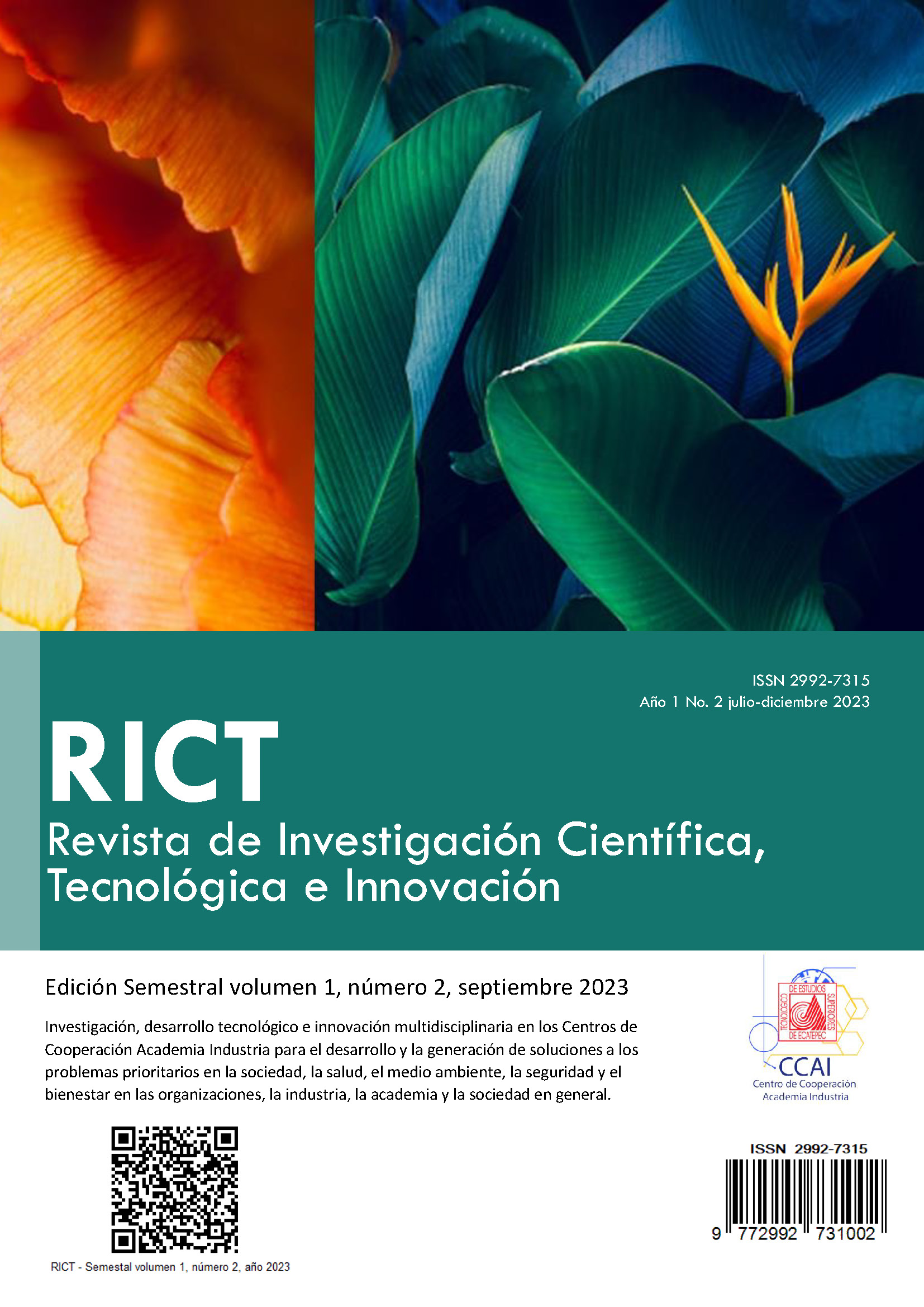Implementación de algoritmos matemáticos para la solución de sistemas de ecuaciones diferenciales que modelan el contagio y la mortalidad por el virus COVID-19 en México
Palabras clave:
Algoritmo, modelo matemático, infección, mortalidad, programación Python, Covid-19, solución numérica de sistemas de ecuaciones diferenciales ordinariaResumen
En el artículo se pretende realizar un modelo matemático de la infección y la mortalidad causadas por el virus COVID-19 en México, el caso de estudio es la ciudad de México (CDMX) durante los primeros meses en los que fue aumentando la pandemia en nuestro país, que fueron lo meses de Mayo – Noviembre 2020, a través de un modelo simple representado por un sistema de ecuaciones , ordinarias (EDOs), al cual se le da solución mediante los algoritmos numéricos de Euler, Heun (Euler mejorado) y Runge-Kutta que son implementados en el lenguaje de programación Python. Se analizan las infecciones y las muertes pronosticadas por el modelo y se comparan con los datos oficiales para la validez de éste. Adicionalmente, se hace un análisis cualitativo de la eficiencia y exactitud de los algoritmos al resolver las ecuaciones planteadas en el modelo.
Citas
Page, J., Hinshaw, D., & McKay, B. (2021, febrero 26). In hunt for Covid-19 origin, patient zero points to second Wuhan market. Wall Street Journal (Eastern Ed.). https://www.wsj.com/articles/in-hunt-for-covid-19-origin-patient-zero-points-to-second-wuhan-market-11614335404.
NCBI Epidemiología de COVID-19 en México: del 27 de febrero al 30 de abril de 2020 (s. f.). Recuperado 2 de octubre de 2022, de https://www.ncbi.nlm.nih.gov/pmc/articles/PMC7250750/.
COVID-19 tablero México. (s/f). COVID - 19 Tablero México. Recuperado el 2 de octubre de 2022, de https://datos.covid-19.conacyt.mx/.
COVID-19 tablero CDMX. (s/f). Geoint COVID - 19 Tablero CDMX. Recuperado el 2 de octubre de 2022, de https://cdmx.dash.covid19.geoint.mx/.
Fred Brauer, Carlos Castillo-Chavez, Zhilian Feng (2019) Mathematical Models in Epidemiology. Springer Science, 0939-2475.
Bernoulli, D. (1766) Essai d’une nouvelle analyse de la mortalité causeé par la petite vérole, Mem. Math. Phys. Acad. Roy. Sci. Paris, 1–45.
Snow, J. (1855) The mode of communication of cholera (2 nd ed.), Churchill, London.
En’ko, P.D. (1889) On the course of epidemics of some infectious diseases, Vrach. St. Petersburg, X: 1008–1010, 1039–1042, 1061–1063. [translated from Russian by K. Dietz, Int. J. Epidemiology (1989) 18: 749–755].
Emilia Vynnycky, Richard G -White (2010,) An Introduction to Infectious Disease Modelling, OXFORD University Press 978-0-19-856-576-5.
Kermack, W.O. & A.G. McKendrick (1927) A contribution to the mathematical theory of epidemics, Proc. Royal Soc. London, 115:700–721.
Kermack, W.O. & A.G. McKendrick (1932) Contributions to the mathematical theory of epidemics, part. II, Proc. Roy. Soc. London, 138:55–83.
Kermack, W.O. & A.G. McKendrick (1933) Contributions to the mathematical theory of epidemics, part. III, Proc. Roy. Soc. London, 141:94–112.
Ross, R.A.(1911) The prevention of malaria (2nd edition, with Addendum). John Murray, London.
Hamer, W.H. (1906) Epidemic disease in England - the evidence of variability and of persistence, The Lancet 167: 733–738.
Tan, X., Yuan, L., Zhou, J., Zheng, Y., & Yang, F. (2013). Modeling the initial transmission dynamics of influenza A H1N1 in Guangdong Province, China. International Journal of Infectious Diseases: IJID: Official Publication of the International Society for Infectious Diseases, 17(7), e479-84. https://doi.org/10.1016/j.ijid.2012.11.018.
Barbarossa, M.V., A Denes, G. Kiss, Y. Nakata, G. Rost, & Z. Vizi (2015) Transmission dynamics and final epidemic size of Ebola virus disease dynamics with varying interventions, PLoS One 10(7): e0131398. https://doi.org/10.1371/journalpone.0131398.
Diekmann, O. & J.A.P. Heesterbeek (2000) Mathematical epidemiology of infectious diseases: Model building, analysis and interpretation, John Wiley and Sons, ltd.
Kapetanovic, A. L., & Poljak, D. (2020). Modeling the epidemic outbreak and dynamics of COVID-19 in Croatia. 2020 5th International Conference on Smart and Sustainable Technologies (SpliTech), 1–5.
Avila-Ponce de León, U., Pérez, Á. G. C., & Avila-Vales, E. (2020). An SEIARD epidemic model for COVID-19 in Mexico: Mathematical analysis and state-level forecast. Chaos, Solitons, and Fractals, 140(110165), 110165. https://doi.org/10.1016/j.chaos.2020.110165.
Michael Y. Li (2018) An Introduction to Mathematical Modeling of Infectious Diseases, Springer 978-3319721217.
Wu, Y., Kang, L., Guo, Z., Liu, J., Liu, M., & Liang, W. (2022). Incubation period of COVID-19 caused by unique SARS-CoV-2 strains: A systematic review and meta-analysis: A systematic review and meta-analysis. JAMA Network Open, 5(8), e2228008. https://doi.org/10.1001/jamanetworkopen.2022.28008.
Xin, H., Li, Y., Wu, P., Li, Z., Lau, E. H. Y., Qin, Y., Wang, L., Cowling, B. J., Tsang, T. K., & Li, Z. (2022). Estimating the latent period of Coronavirus disease 2019 (COVID-19). Clinical Infectious Diseases: An Official Publication of the Infectious Diseases Society of America, 74(9), 1678–1681. https://doi.org/10.1093/cid/ciab746
Parry, A. E., Sheel, M., & Housen, T. (2020, abril 12). How long are you infectious when you have coronavirus? The Conversation. http://theconversation.com/how-long-are-you-infectious-when-you-have-coronavirus-135295.
Ordinary Differenctial Equations An Elementary Textbook for Students of Mathematics, Engineering, and the Sciences (Morris Tenenbaum, Harry Pollard).
Estimating the Latent Period of Coronavirus Disease 2019 (COVID-19). (s/f). Oup.com. Recuperado el 2 de octubre de 2022, de https://academic.oup.com/cid/article/74/9/1678/6359063.
Tariq, A., Banda, J. M., Skums, P., Dahal, S., Castillo-Garsow, C., Espinoza, B., Brizuela, N. G., Saenz, R. A., Kirpich, A., Luo, R., Srivastava, A., Gutierrez, H., Chan, N. G., Bento, A. I., Jimenez-Corona, M.-E., & Chowell, G. (2021). Transmission dynamics and forecasts of the COVID-19 pandemic in Mexico, March-December 2020. PloS One, 16(7), e0254826. https://doi.org/10.1371/journal.pone.0254826.
Tracking SARS-CoV-2 variants. (s/f). Who.int. Recuperado el 2 de octubre de 2022, de https://www.who.int/activities/tracking-SARS-CoV-2-variants.
García, F. J., 2007. Título del libro. Nombre de la editorial, Lugar de publicación.
García, F. J., Martínez, R., (2008). Título del artículo. Nombre de la revista número volumen, números de página.
Michael Y. Li (2018) An Introduction to Mathematical Modeling of Infectious Diseases, Springer 978-3319721217.
Descargas
Publicado
Cómo citar
Número
Sección
Licencia
Derechos de autor 2023 Javier Norberto Gutierrez Villegas, Israel Isaac Gutierrez Villegas, Marco Antonio Gutiérrez Villegas, Esiquio Martín Gutiérrez Armenta, Minerva del mar Gutierrez Armenta, Juan Manuel Figueroa Flores, Áyax Saúl Martínez Magaña

Esta obra está bajo una licencia internacional Creative Commons Atribución-NoComercial-SinDerivadas 4.0.










